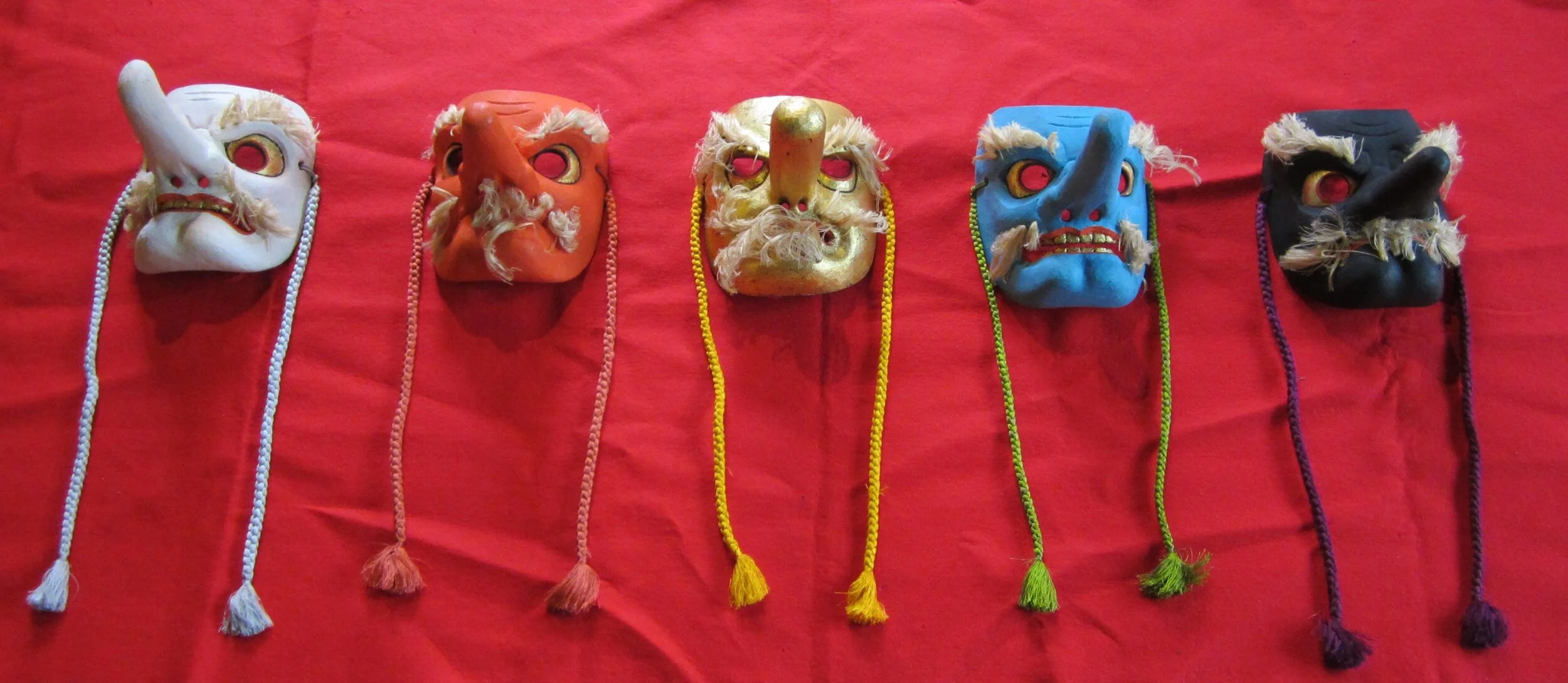Autumn Festival:
Visitors from the Forest
Every year, a group of legendary creatures arrives at Otagi Nenbutsuji on the second Sunday of November at 1:00pm.
These five creatures are known as tengu, mythical beasts with long noses, bushy mustaches, and a penchant for merrymaking. Known to live deep in the forests of Japan, they appear in legends as both evil spirits and benevolent protectors of the woods. So important are the tengu to Japanese culture that they even have their own emoji: 👺 Gifted with the power of flight and an incredible prowess for martial arts, tengu are said to be creatures that inspire both fear and admiration.
Thankfully, the tengu that come to Otagi Nenbutsuji are friendly forest guardians who seek only to amuse onlookers and bless them with their magic. These visitors come to help celebrate the turning of the season under a canopy of vibrant autumn leaves. In a mix of Buddhist tradition and local superstition, the festival is sure to be a memorable experience for the lucky few who witness this rare event.
A Noisy History
The roots of this celebration stretch back more than a millennia. Otagi Nenbutsuji Temple was originally founded in the 8th century on the other side of Kyoto City, just south of the Gion district. The neighborhood became known for its many archery shops, the air thick with the cries of merchants shouting”Tsurumeso!” (“come try my wares!”). Even today, the area still bears the name Yumiyacho, meaning Bow and Arrow Town.
Archery was not the only draw to Yumiyacho. The New Year festival at Otagi Nenbutsuji grew in fame as well. Priests known as gyoja conducted this annual ritual. These holy men practiced a syncretic form of religion called Shugendo that mixed Buddhist asceticism with Shinto nature-worship. Part of the New Year ritual was the noisy slapping of wooden clapboards against holy paper talismans pasted onto the temple walls. Locals would then take these paper slips home for good luck in the coming year.
Between the shouts of the archery merchants and the wild cracking and smacking of the wooden sticks, the district became known as a rather raucous part of of town. The noisy New Year revelry was officially known as tenku, meaning a “carrying of offerings” to the local gods. Over time, the locals instead began referring to the noisy, wild gyoja in their rustic costumes as tengu, mythical wild beasts from the forest. Known unofficially as Tengu no Sakamori - Merrymaking of the Tengu - the festival persisted until the late 19th century when the Meiji government forcibly separated Buddhist and Shinto practices.
Ritual and Revelry
After a century of silence, the wild cries of the festival were heard once again. Kocho Nishimura, head priest of Otagi Nenbutsuji in the second half of the 20th century, revived the celebration as an autumn festival. Masks were created to bring a colorful authenticity to the revelry, as the priests who until now had only been as noisy as tengu became tengu in fact. This is fitting, as Otagi Nenbutsuji is nestled at the base of Mt. Atago. Since ancient times, this peak has been known as the home of Tarobo, one of the three legendary tengu kings of Japan.
The festival beings with traditional Buddhist prayers by the head priest. Incense is lit and soon the voices of five gyoja priests in their homespun Shugendo robes join the chanting, the iron rings of their wooden scepters jangling in time to the beat of a large drum.
Prayers complete, the five gyoja depart the temple. Soon thereafter, five wild tengu appear carrying wooden clapboards. They make their way through the crowd, voices squawking in the incomprehensible language of the forest. Their wooden boards clack clack clack as they march through the crowd. Adults smile and call out welcomes to the beasts, while children fight back tears and put on a brave face against these strange forest dwellers.
The archery theme from Yumiyacho is kept intact with the tengu bringing their lucky bow along to this once-a-year meeting of man and nature. The turquoise-faced tengu draws and shoots five arrows into the sky. Those lucky enough to catch one of these shafts are guaranteed good fortune, creating a wild dash among the onlookers to the spots where these arrows land.
The tengu then parade around the temple before entering and bestowing individual blessings upon eager crowd members. This is an exceedingly rare blessing; the sacred words of the forest croaked out from the throat of a powerful tengu bring good luck to those who hear it. It’s certain that you’ll be the only person you know who can say they’ve met a “real” tengu in Japan.
Tengu are notoriously shy, so the autumn festival remains a small, personal affair. Like all events at Otagi Nenbutsuji, it is a wonderful way to connect with the community and witness something truly unique.
Come meet the tengu for yourself on the second Sunday of November at 1:00pm.





